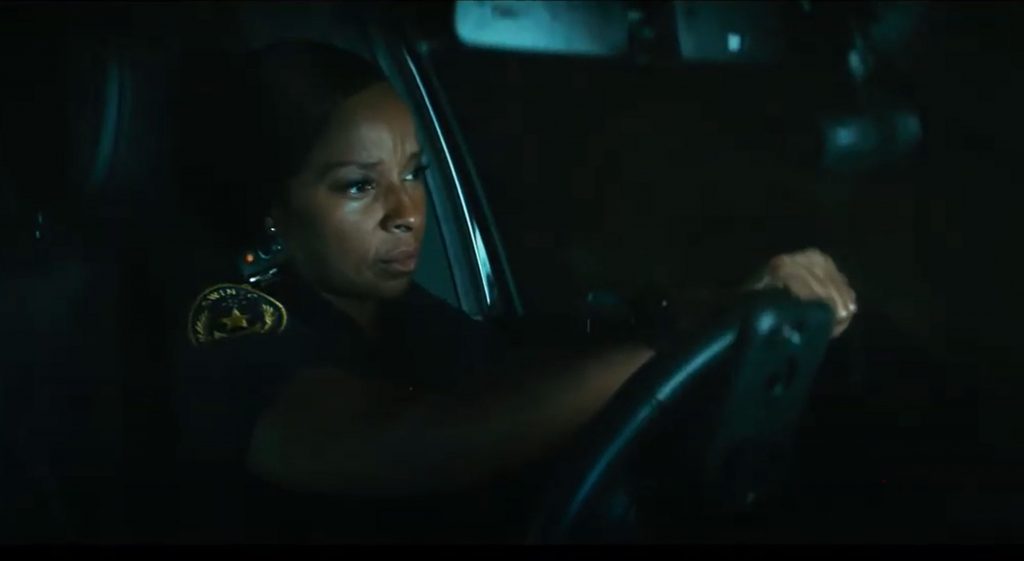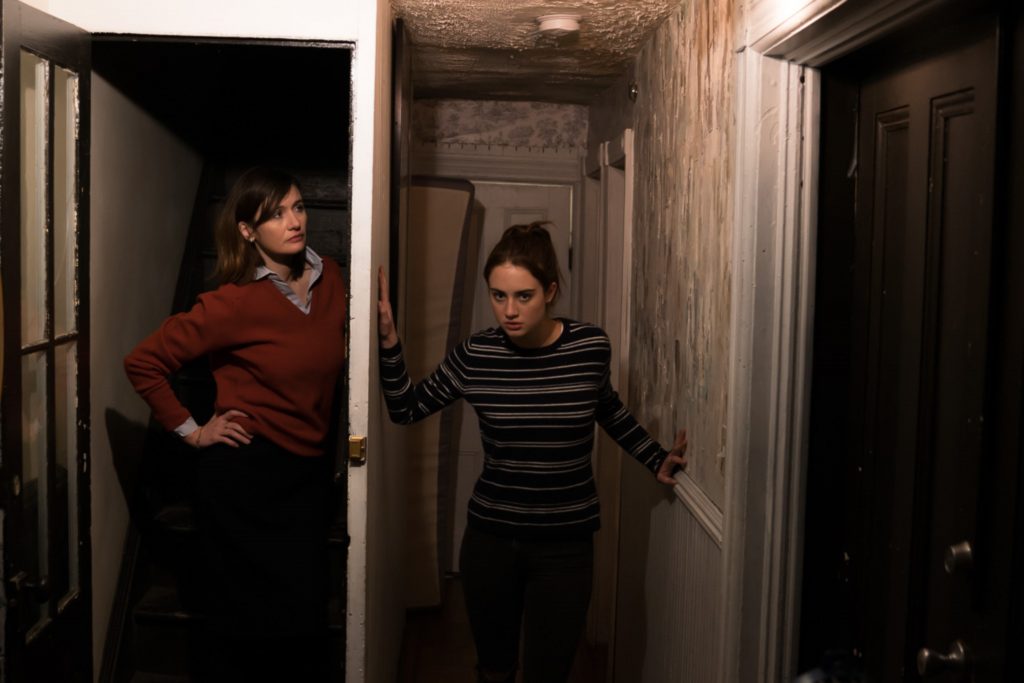November 8, 2020
by Carla Hay

Directed by André Øvredal
Some language in Norwegian with subtitles
Culture Representation: Taking place in Norway, the sci-fi thriller “Mortal” features an almost all-white cast of characters (and one Indian) representing the middle-class.
Culture Clash: A mysterious young man is hunted by authorities because he has a lethal ability to conduct energy and electricity through his body.
Culture Audience: “Mortal” will appeal primarily to people who like formulaic sci-fi flicks that put more emphasis on visual effects than in crafting a good story.

“Mortal” starts off as a run-of-the-mill sci-fi flick before it turns into a ludicrous off-the-rails story. Even before the plot twist is revealed in the last third of the movie, “Mortal” had too many weak links for it to be strengthened by the “surprise” ending. This plot twist actually makes the movie worse, because the ill-conceived, drastic turn in the story looks very tacked-on and rushed. It’s as if the filmmakers were desperate to come up with an ending to bring “Mortal” out its repetitive rut.
Directed by André Øvredal (who co-wrote the screenplay with Norman Lesperance and Geoff Bussetil), “Mortal” is essentially a sci-fi chase movie that doesn’t really go anywhere. The movie centers on an American man in his mid-20s named Eric Bergland (played by Nat Wolff), who is in Norway looking for his relatives. The details of his family aren’t revealed until toward the end of the movie, because it’s part of the plot twist.
And so, for almost the entire movie, viewers don’t know anything about Eric except that he’s homeless in Norway and he has a very strange and deadly power: He can conduct and transport energy (especially electrical energy) through his body, giving him the ability to start fires and cause electrical storms. In the beginning of the film, Eric is by himself, looking like he’s a dirty and disheveled vagrant who’s trying to hide from the world.
He trespasses into a home to steal some scissors, medicine, bandages and candy. He eats the candy as if he’s been starving for days. He uses the scissors to cut his hair. And he uses the medicine and bandages to treat a festering wound on his leg.
It’s revealed later in the movie that Eric can get burns on his body when he’s at his peak of energy-conducting power. Viewers will have to suspend disbelief that Eric can be burned everywhere on his body except his face, because nothing bad ever happens to his face except for the unfortunate straggly beard that Eric has at the beginning of the film.
At a gas station in the municipality of Odda, Eric catches the attention of four teenagers (three boys and a girl) in a car. A bullying guy named Ole (played by Arthur Hakalahti), who’s the leader of the group, taunts Eric for looking like the dirty transient that he is. The car then happens to follow Eric to an open field.
Ole gets out of the car, while the other teens follow him and Eric into the field. Ole continues to harass Eric, who warns Ole in an ominous voice: “If you touch me, you will burn.” But of course, Ole touches Eric. And when he does, Eric stares at Ole intensely, while Ole appears to be suffocating without Eric touching him. Ole then immediately collapses and dies.
Eric is quickly apprehended by authorities, who don’t find out much about Eric except for these three things: (1) He’s a backpacker from the United States, but he’s of Norwegian heritage; (2) He’s in Norway to look for his relatives; and (3) He was seen at a farmhouse in Årdal, a municipality in Norway’s Vestland county, where three years before, a fire killed five people at the house. Eric is suspected of starting the fire, but he’s not talking to law enforcement about what happened at that house.
The sheriff of Odda is Henrik Jondal (played by Per Frisch), who’s in charge of the investigation into the death of Ole. The police aren’t making any progress in interviewing Eric, because he refuses to say much to them, so Henrik has the idea to call someone who has experience counseling teenagers and other young people. The hope is that this counselor will be able to break through to Eric and get him to open up about the death of Ole.
The counselor’s name is Christine Aas (played by Iben Akerlie), and she looks like she’s approximately the same age as Eric. And as soon as she appears on screen, it’s easy to see that she’s going to be Eric’s love interest because she has the stereotypical physical appearance (young, blonde and pretty) of a love interest in a formulaic movie like this one.
Even though Christine looks young enough to only be a few years out of college, the movie has made her a whiz at diagnosing medical conditions because she figures out very quickly what Alex’s superpower is. Not long after Christine is put in a police interrogation room with Eric to ask him some questions, he goes from being mute to gasping remorsefully about Ole, “I tried to tell him not to touch me.”
Meanwhile, Henrik is in another section of the police station, where he’s dealing with the parents of Ole, who want answers about what caused Ole’s death. Ole’s father Bjørn (played by Per Egil Aske) is very angry because he knows that the police have Eric in custody as a suspect. (The arrest has been all over the news.) Bjørn demands to be in a room alone with Eric, but Henrik refuses. It’s pretty clear at this point that this won’t be the last we see of Bjørn, who might as well have worn a T-shirt that says “Vigilante Justice,” because that seems to be the only purpose for his character in this movie.
Back in the police interrogation room, Eric reaches for a glass of water, and Christine sees that he’s able to lift the water out of the glass, just by putting his hand above the glass. This gives him such electrical energy force throughout his body, that when Eric places his hands on the wooden table, it scorches the table. And then, Eric gets so upset, the entire room lights up with an electrical storm caused by Eric.
Christine tells Eric the obvious: The energy comes out when he’s experiencing negative emotions, such as fear, anger or anxiety. She tells him that he can control the energy if he just breathes and calms down and gets to a relaxed emotional state. Now that Little Miss Expert has diagnosed Eric’s problem in a matter of minutes, you almost expect her to say, “I’ll be right back. Let me get a yoga mat for you so we can do some breathing exercises.”
Henrik rushes in and witnesses the “electrical storm” in the room, and everyone rushes out before more damage can be caused. The authorities sedate Eric with medication. And a U.S. Embassy official named Cora Hathaway (played by Priyanka Bose) is summoned to take Eric by helicopter to a place that isn’t made clear in the movie because this movie’s screenplay is kind of a sloppy mess. However, viewers can assume that he’s going somewhere for scientific tests.
Eric is strapped to a gurney during the helicopter ride. But when he wakes up and sees that he’s essentially being imprisoned against his will, he goes crazy and creates such a big electrical storm that it causes the helicopter to crash into the ocean. Everyone on the plane dies except for Cora (who ends up in a hospital) and Eric, who has temporarily disappeared. Cora eventually gets released from the hospital and makes it her mission to track down Eric so he can be put back into the custody of the government.
Meanwhile, Eric shows up in the outdoor parking lot of the apartment building where Christine just happens to be at that moment. Somehow, in the short time that Christine and Eric have known each other, Eric has managed to find out where Christine lives. Viewers will have to assume that he was able to look up that information in between causing electrical storms, surviving a helicopter crash in the ocean, finding his way back to land, and then showing up at Christine’s place in the hopes that she’ll want to hang out with him while he’s a fugitive.
It turns out that Christine does want to hang out with Eric and help him elude capture by law enforcement. She tells him, “I’m going take you to my friend’s cabin, and we’re going to figure it out.” The rest of the movie is basically Eric and Christine going on the run together. There’s only one moment when Christine doubts her decision to help Eric, but she shows the kind of immediate loyalty to him that makes it obvious she’s romantically attracted to him. Eric and Christine’s inevitable “big moment” kiss comes later in the movie.
Wolff is serviceable in this poorly written role. He tries to infuse a “lost soul” persona into Eric’s character, but the character is so vague that it’s a wasted effort to try to bring gravitas to the role. The problem is that “Mortal” tells almost nothing about Eric and his background until toward the end of the film, which makes it hard for viewers to root for Eric while he tries to evade capture. The other actors in the film are mediocre, while Bose is just plain awful with her emotionless, wooden delivery of her lines.
And speaking of the U.S. Embassy official Cora, it doesn’t make sense that she would be heading up the task force to find Eric. Embassy officials are political diplomats, not law enforcement or part of a government’s military defense. Based on all the destruction that Eric causes in the movie, the Norwegian military would be the ones to take over if a seemingly crazy guy was out there causing electrical storms that are bad enough to burn bridges, roads, buildings and people.
Even though Cora has seen firsthand how dangerous Eric can be, she wears no protective gear the entire time that she’s trying to hunt him down. She’s dressed as if she’s about to go for a nature hike. And the only indication that she survived a traumatic plane crash in the ocean is that she has a small band-aid on her forehead. Yes, this movie is that stupid.
As for Eric’s big “secret” at the end of the movie, it looks like a blatant cash grab to latch on to the popularity of a certain blockbuster movie franchise. It’s too bad that the filmmakers of “Mortal” couldn’t come up with a more original story. The visual effects and cinematography in “Mortal” are fairly good, but because of the moronic way that this story is told, it doesn’t matter how good the movie’s visuals might look if the dialogue and basic storyline are of such low quality that it’s embarrassing. All the electrical storms and fires concocted for this movie still can’t ignite the film’s very dull and unimaginative plot.
Saban Films released “Mortal” in select U.S. cinemas, on digital and VOD on November 6, 2020. The movie’s Blu-ray and DVD release date is November 10, 2020.







